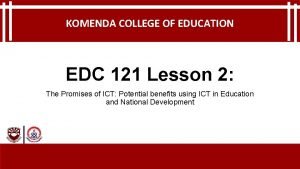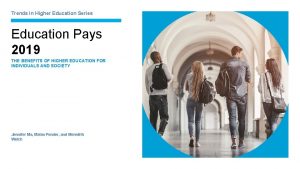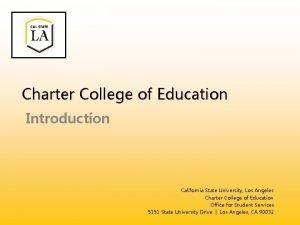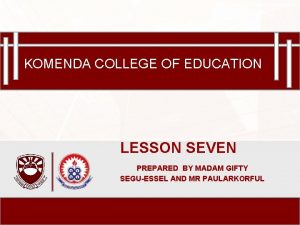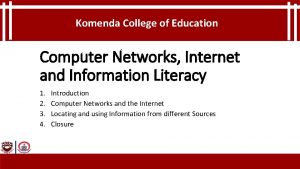Komenda College of Education KOMENDA COLLEGE OF EDUCATION















- Slides: 15

Komenda College of Education KOMENDA COLLEGE OF EDUCATION LESSON EIGHT (8) CONCEPTS OF LEARNING AND LEARNING STYLES: VAK LEARNING MODEL AND EDUCATIONAL IMPLICATIONS Prepared by Gifty Segu-Essel and Mr Paul Arkorful

Komenda College of Education CLICK TO ADD TITLE • CONCEPTS OF LEARNING AND LEARNING STYLES: VAK LEARNING MODEL AND EDUCATIONAL IMPLICATIONS LESSON OUTLINE • Meaning of Learning • Factors Influencing Learning • Definition of learning style • VAK learning style and their educational implications. •

Komenda College of Education CLICK TO ADD TITLE • MEANING OF LEARNING • Learning is defined as a process where an organism changes its behaviour as a result of experience

Komenda College of Education CLICK TO ADD TITLE Factors Influencing Learning • Level of intelligence • Readiness and maturation • Nature of Material Learned • Socio-economic factor • Gender Factor • Emotional factors

Komenda College of Education CLICK TO ADD TITLE Definition of learning style • Learning style simply refers to an individual’s preferred way of learning. A learning style can also be defined as “an individual’s mode of gaining knowledge” (Dictionary. com, 2012)

Komenda College of Education CLICK TO ADD TITLE TYPES OF LEARNING STYLES/LEARNERS • Auditory learner for someone who learns best when they hear instructional materials. • Visual learner for someone who prefers material to be presented in a visual format. • Tactile-kinaesthetic learner for a person who learns most effectively through hands-on experience.

Komenda College of Education CLICK TO ADD TITLE THE VAK LEARNING STYLES V – VISUAL LEARNING STYLE A – AUDITOTY LEARNING STYLE K – KINAESTHETIC LEARNING STYLE

Komenda College of Education CLICK TO ADD TITLE • The VAK Learning Styles were developed by psychologists in the 1920 s. It indicates the most common ways in which people learn and consists of three classifications, namely the Visual, Auditory, and Kinesthetic learning styles.

Komenda College of Education CLICK TO ADD TITLE • Visual learners: have two sub-channels— linguistic and spatial. Learners who are visual-linguistic like to learn through written language, such as reading and writing tasks.

Komenda College of Education CLICK TO ADD TITLE • IMPLICATIONS OF VISUAL LEARNER’S IN EDUCATION • Use graphs, charts, illustrations, or other visual aids. • Include outlines, concept maps, agendas, handouts, etc. for reading and taking notes. • Include plenty of content in hand-outs to reread after the learning session. • Leave white space in hand-outs for note-taking. • Invite questions to help them stay alert in auditory environments.

Komenda College of Education CLICK TO ADD TITLE • Auditory Learners: often talk to themselves. They also may move their lips and read out loud. They may have difficulty with reading and writing tasks. They often do better talking to a colleague or a tape recorder and hearing what was said.

Komenda College of Education CLICK TO ADD TITLE EDUCATIONAL IMPLICATIONS OF AUDITORY LEARNERS • Begin new material with a brief explanation of what is coming. • Use the Socratic method of lecturing by questioning learners to draw as much information from them as possible and then fill in the gaps with your own expertise. • Include auditory activities, such as brainstorming • Have the learners verbalize the questions. • Develop an internal dialogue between yourself and the learn

Komenda College of Education CLICK TO ADD TITLE Kinesthetic learners: do best while touching and moving. It also has two subchannels: kinaesthetic (movement) and tactile (touch).

Komenda College of Education CLICK TO ADD TITLE EDUCATIONAL IMPLICATIONS OF KINAESTHETIC LEARNERS • Use activities that get the learners up and moving. • Play music, when appropriate, during activities. • Use coloured markers to emphasize key points on flip charts or white boards. • Give frequent stretch breaks (brain breaks). • Provide high lighters, colour pens and/or pencils. • Guide learners through a visualization of complex tasks. • Have them transfer information from the text to another medium such as a keyboard or a tablet.

Komenda College of Education CLICK TO ADD TITLE THANK YOU www. komendacollege. edu. gh
 Struktury policji
Struktury policji Dr komenda
Dr komenda Komenda miejska policji w tarnowie
Komenda miejska policji w tarnowie Komenda tracert
Komenda tracert Wojskowa komenda
Wojskowa komenda Wake tech admissions
Wake tech admissions Early college high school at midland college
Early college high school at midland college College board education pays 2019
College board education pays 2019 Havering college of further and higher education
Havering college of further and higher education Case study ethan and college expenses
Case study ethan and college expenses Bladen community college continuing education
Bladen community college continuing education Gordon college of education
Gordon college of education Salahaddin university college of education
Salahaddin university college of education Chu hai college of higher education
Chu hai college of higher education Cal state la charter college of education
Cal state la charter college of education Formal and non formal education venn diagram
Formal and non formal education venn diagram

